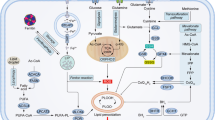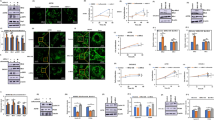Abstract
Reactive oxygen species (ROS) such as superoxide and hydrogen peroxide (H2O2) have been implicated in development and progression of breast cancer. In the present study, we have evaluated the effects of the superoxide dismutase (SOD) mimetic MnTmPyP and the SOD/catalase mimetic EUK 134 on superoxide and H2O2 formation as well as proliferation, adhesion, and migration of MCF-7 and MDA-MB-231 cells. Superoxide and H2O2 production was examined using dihydroethidium and Amplex red assays, respectively. Cell viability and adhesion were measured using a tetrazolium-based MTT assay. Cell proliferation was determined using trypan blue assay. Cell cycle progression was analyzed using flow cytometry. Clonal expansion of a single cell was performed using a colony formation assay. Cell migration was measured using transwell migration assay. Dual luciferase assay was used to determine NF-κB reporter activity. EUK 134 effectively reduced both superoxide and H2O2, whereas MnTmPyP removed superoxide but enhanced H2O2 formation. EUK 134 effectively attenuated viability, proliferation, clonal expansion, adhesion, and migration of MCF-7 and MDA-MB-231 cells. In contrast, MnTmPyP only reduced clonal expansion of MCF-7 and MDA-MB-231 cells but had no effect on adhesion and cell cycle progression. Tumor necrosis factor-alpha-induced NF-κB activity was reduced by EUK 134, whereas MnTmPyP enhanced this activity. These data indicate that the SOD mimetic MnTmPyP and the SOD/catalase mimetic EUK 134 exert differential effects on breast cancer cell growth. Inhibition of H2O2 signaling using EUK 134-like compound might be a promising approach to breast cancer therapy.







Similar content being viewed by others
Abbreviations
- EUK 134:
-
Eukaration-134; chloro[[2,2′-[1,2-ethanediylbis[(nitrilo-κN)methylidyne]]bis[6-methoxyphenolato-κO]]]-manganese
- H2O2 :
-
Hydrogen peroxide
- HMEC:
-
Human dermal microvascular endothelial cells
- MnTmPyP:
-
Mn(III)tetrakis(1-methyl-4-pyridyl)porphyrin pentachloride
- NF-κB:
-
Nuclear factor kappa B
- ROS:
-
Reactive oxygen species
- SOD:
-
Superoxide dismutase
- TNFα:
-
Tumor necrosis factor-alpha
References
Ahmed A (2010) Prognostic and therapeutic role of nuclear factor-kappa B (NF-kappaB) in breast cancer. JAMC 22:218–221
Batinic-Haberle I, Reboucas JS, Spasojevic I (2010) Superoxide dismutase mimics: chemistry, pharmacology, and therapeutic potential. Antioxid Redox Signal 13:877–918. doi:10.1089/ars.2009.2876
Bours V, Bentires-Alj M, Hellin AC, Viatour P, Robe P, Delhalle S, Benoit V, Merville MP (2000) Nuclear factor-kappa B, cancer, and apoptosis. Biochem Pharmacol 60:1085–1089
Cheng H, Lee SH, Wu S (2013) Effects of N-acetyl-l-cysteine on adhesive strength between breast cancer cell and extracellular matrix proteins after ionizing radiation. Life Sci 93:798–803. doi:10.1016/j.lfs.2013.09.029
Davies KJ (1999) The broad spectrum of responses to oxidants in proliferating cells: a new paradigm for oxidative stress. IUBMB Life 48:41–47. doi:10.1080/713803463
Evans MK, Tovmasyan A, Batinic-Haberle I, Devi GR (2014) Mn porphyrin in combination with ascorbate acts as a pro-oxidant and mediates caspase-independent cancer cell death. Free Radic Biol Med 68:302–314. doi:10.1016/j.freeradbiomed.2013.11.031
Giorgio M, Trinei M, Migliaccio E, Pelicci PG (2007) Hydrogen peroxide: a metabolic by-product or a common mediator of ageing signals? Nature reviews. Mol cell Biol 8:722–728. doi:10.1038/nrm2240
Glorieux C, Auquier J, Dejeans N, Sid B, Demoulin JB, Bertrand L, Verrax J, Calderon PB (2014) Catalase expression in MCF-7 breast cancer cells is mainly controlled by PI3 K/Akt/mTor signaling pathway. Biochem Pharmacol 89:217–223. doi:10.1016/j.bcp.2014.02.025
Glorieux C, Dejeans N, Sid B, Beck R, Calderon PB, Verrax J (2011) Catalase overexpression in mammary cancer cells leads to a less aggressive phenotype and an altered response to chemotherapy. Biochem Pharmacol 82:1384–1390. doi:10.1016/j.bcp.2011.06.007
Haffner MC, Berlato C, Doppler W (2006) Exploiting our knowledge of NF-kappaB signaling for the treatment of mammary cancer. J Mammary Gland Biol Neoplas 11:63–73. doi:10.1007/s10911-006-9013-5
Hernandez-Aya LF, Gonzalez-Angulo AM (2011) Targeting the phosphatidylinositol 3-kinase signaling pathway in breast cancer. Oncologist 16:404–414. doi:10.1634/theoncologist.2010-0402
Kattan Z, Minig V, Leroy P, Dauca M, Becuwe P (2008) Role of manganese superoxide dismutase on growth and invasive properties of human estrogen-independent breast cancer cells. Breast Cancer Res Treat 108:203–215. doi:10.1007/s10549-007-9597-5
Kundu N, Zhang S, Fulton AM (1995) Sublethal oxidative stress inhibits tumor cell adhesion and enhances experimental metastasis of murine mammary carcinoma. Clin Exp Metastasis 13:16–22
Liu GS, Tsai HE, Weng WT, Liu LF, Weng CH, Chuang MR, Lam HC, Wu CS, Tee R, Wen ZH, Howng SL, Tai MH (2011) Systemic pro-opiomelanocortin expression induces melanogenic differentiation and inhibits tumor angiogenesis in established mouse melanoma. Hum Gene Ther 22:325–335. doi:10.1089/hum.2010.090
McAuliffe PF, Meric-Bernstam F, Mills GB, Gonzalez-Angulo AM (2010) Deciphering the role of PI3 K/Akt/mTOR pathway in breast cancer biology and pathogenesis. Clin Breast Cancer 10(Suppl 3):S59–S65. doi:10.3816/CBC.2010.s.013
Oliveira-Marques V, Marinho HS, Cyrne L, Antunes F (2009) Role of hydrogen peroxide in NF-kappaB activation: from inducer to modulator. Antioxid Redox Signal 11:2223–2243. doi:10.1089/ARS.2009.2601
Oskarsson T (2013) Extracellular matrix components in breast cancer progression and metastasis. Breast 22(Suppl 2):S66–S72. doi:10.1016/j.breast.2013.07.012
Peshavariya H, Dusting GJ, Jiang F, Halmos LR, Sobey CG, Drummond GR, Selemidis S (2009) NADPH oxidase isoform selective regulation of endothelial cell proliferation and survival. Naunyn-Schmiedeberg’s Arch Pharmacol 380:193–204. doi:10.1007/s00210-009-0413-0
Peshavariya HM, Chan EC, Liu GS, Jiang F, Dusting GJ (2014) Transforming growth factor-beta1 requires NADPH oxidase 4 for angiogenesis in vitro and in vivo. J Cell Mol Med. doi:10.1111/jcmm.12263
Peshavariya HM, Dusting GJ, Selemidis S (2007) Analysis of dihydroethidium fluorescence for the detection of intracellular and extracellular superoxide produced by NADPH oxidase. Free Radic Res 41:699–712. doi:10.1080/10715760701297354
Peshavariya HM, Liu GS, Chang CW, Jiang F, Chan EC, Dusting GJ (2014) Prostacyclin signaling boosts NADPH oxidase 4 in the endothelium promoting cytoprotection and angiogenesis. Antioxid Redox Signal 20:2710–2725. doi:10.1089/ars.2013.5374
Peshavariya HM, Taylor CJ, Goh C, Liu GS, Jiang F, Chan EC, Dusting GJ (2013) Annexin peptide Ac2-26 suppresses TNFalpha-induced inflammatory responses via inhibition of Rac1-dependent NADPH oxidase in human endothelial cells. PLoS One 8:e60790. doi:10.1371/journal.pone.0060790
Policastro L, Molinari B, Larcher F, Blanco P, Podhajcer OL, Costa CS, Rojas P, Duran H (2004) Imbalance of antioxidant enzymes in tumor cells and inhibition of proliferation and malignant features by scavenging hydrogen peroxide. Mol Carcinog 39:103–113. doi:10.1002/mc.20001
Prasad S, Ravindran J, Aggarwal BB (2010) NF-kappaB and cancer: how intimate is this relationship. Mol Cell Biochem 336:25–37. doi:10.1007/s11010-009-0267-2
Punnonen K, Ahotupa M, Asaishi K, Hyoty M, Kudo R, Punnonen R (1994) Antioxidant enzyme activities and oxidative stress in human breast cancer. J Cancer Res Clin Oncol 120:374–377
Rawal RM, Patel PS, Vyas RK, Sainger RN, Shah MH, Peshavariya HM, Patel DD, Bhatavdekar JM (2001) Role of pretherapeutic biomarkers in predicting postoperative radiotherapy response in patients with advanced squamous cell carcinoma. Int J Radiat Biol 77:1141–1146. doi:10.1080/09553000110067788
Rojanasakul Y, Ye J, Chen F, Wang L, Cheng N, Castranova V, Vallyathan V, Shi X (1999) Dependence of NF-kappaB activation and free radical generation on silica-induced TNF-alpha production in macrophages. Mol Cell Biochem 200:119–125
Rosenthal RA, Fish B, Hill RP, Huffman KD, Lazarova Z, Mahmood J, Medhora M, Molthen R, Moulder JE, Sonis ST, Tofilon PJ, Doctrow SR (2011) Salen Mn complexes mitigate radiation injury in normal tissues. Anti-Cancer Agents Med Chem 11:359–372
Salvemini D, Riley DP, Cuzzocrea S (2002) SOD mimetics are coming of age. Nat Rev Drug Discov 1:367–374. doi:10.1038/nrd796
Sen S, Kawahara B, Chaudhuri G (2012) Maintenance of higher H(2)O(2) levels, and its mechanism of action to induce growth in breast cancer cells: important roles of bioactive catalase and PP2A. Free Radic Biol Med 53:1541–1551. doi:10.1016/j.freeradbiomed.2012.06.030
Sies H (2014) Role of metabolic H2O2 generation: redox signaling and oxidative stress. J Biol Chem 289:8735–8741. doi:10.1074/jbc.R113.544635
Stone JR, Yang S (2006) Hydrogen peroxide: a signaling messenger. Antioxid Redox Signal 8:243–270. doi:10.1089/ars.2006.8.243
Szatrowski TP, Nathan CF (1991) Production of large amounts of hydrogen peroxide by human tumor cells. Cancer Res 51:794–798
Tas F, Hansel H, Belce A, Ilvan S, Argon A, Camlica H, Topuz E (2005) Oxidative stress in breast cancer. Med Oncol 22:11–15. doi:10.1385/MO:22:1:011
Tochhawng L, Deng S, Pervaiz S, Yap CT (2013) Redox regulation of cancer cell migration and invasion. Mitochondrion 13:246–253. doi:10.1016/j.mito.2012.08.002
Toyokuni S, Okamoto K, Yodoi J, Hiai H (1995) Persistent oxidative stress in cancer. FEBS Lett 358:1–3
Trachootham D, Alexandre J, Huang P (2009) Targeting cancer cells by ROS-mediated mechanisms: a radical therapeutic approach? Nature reviews. Drug Discov 8:579–591. doi:10.1038/nrd2803
Trachootham D, Lu W, Ogasawara MA, Nilsa RD, Huang P (2008) Redox regulation of cell survival. Antioxid Redox Signal 10:1343–1374. doi:10.1089/ars.2007.1957
Weydert CJ, Waugh TA, Ritchie JM, Iyer KS, Smith JL, Li L, Spitz DR, Oberley LW (2006) Overexpression of manganese or copper-zinc superoxide dismutase inhibits breast cancer growth. Free Radic Biol Med 41:226–237. doi:10.1016/j.freeradbiomed.2006.03.015
Weydert CJ, Zhang Y, Sun W, Waugh TA, Teoh ML, Andringa KK, Aykin-Burns N, Spitz DR, Smith BJ, Oberley LW (2008) Increased oxidative stress created by adenoviral MnSOD or CuZnSOD plus BCNU (1,3-bis(2-chloroethyl)-1-nitrosourea) inhibits breast cancer cell growth. Free Radic Biol Med 44:856–867. doi:10.1016/j.freeradbiomed.2007.11.009
Xiao D, Vogel V, Singh SV (2006) Benzyl isothiocyanate-induced apoptosis in human breast cancer cells is initiated by reactive oxygen species and regulated by Bax and Bak. Mol Cancer Ther 5:2931–2945. doi:10.1158/1535-7163.MCT-06-0396
Ye X, Fels D, Tovmasyan A, Aird KM, Dedeugd C, Allensworth JL, Kos I, Park W, Spasojevic I, Devi GR, Dewhirst MW, Leong KW, Batinic-Haberle I (2011) Cytotoxic effects of Mn(III) N-alkylpyridylporphyrins in the presence of cellular reductant, ascorbate. Free Radic Res 45:1289–1306. doi:10.3109/10715762.2011.616199
Acknowledgments
MHS was supported by postdoctoral Fellowship (KG080837) from the Susan G. Komen Foundation for the Cure, USA. GJD is the recipient of an National Health and Medical Research Council Research Fellowship (#1003113). Authors are thankful to Dr. Rachana Sainger for her extensive reading and suggestions for this manuscript. The Centre for Eye Research Australia, St. Vincent’s Institute of Medical Research and O’Brien Institute acknowledge the Victorian State Government’s Department of Innovation, Industry and Regional Development’s Operational Infrastructure Support Program.
Conflict of interest
The authors confirm that there are no conflicts of interest.
Author information
Authors and Affiliations
Corresponding author
Rights and permissions
About this article
Cite this article
Shah, M.H., Liu, GS., Thompson, E.W. et al. Differential effects of superoxide dismutase and superoxide dismutase/catalase mimetics on human breast cancer cells. Breast Cancer Res Treat 150, 523–534 (2015). https://doi.org/10.1007/s10549-015-3329-z
Received:
Accepted:
Published:
Issue Date:
DOI: https://doi.org/10.1007/s10549-015-3329-z




